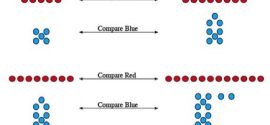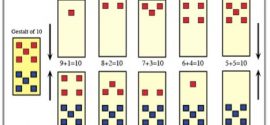Math: Naming Problems
Getting Math Concepts
Math-specific concepts seem to be particularly difficult to master. In addition to being abstract, these concepts contain terms that confound students with visual similarity (divisor vs. dividend) or auditory similarity between homophones (times: multiplication vs. times: hours and minutes, or times: “X” the 24th letter). The terms can become more accessible when presented through concrete demonstrations.
Download the Graphic Organizer for this Fractions Renaming Exercise. Click here.
Chris Woodin has graciously allowed us to offer PDFs of some of the graphic organizers he uses in his classroom. To see more organizers and information, click here.
Difficulties in learning abstract mathematics terms or concepts can be mitigated by providing concrete visual examples that the student can commit to visual memory. Student-generated images of concrete visual examples can prompt a student to name the elements of a fact or procedure. For example, durable images like those of a dog, an ant, or a clock face can be used to concretize the process of renaming fractions. When provided with ample time to formulate responses, students can label information contained within these familiar concrete images and apply these labels to describe procedures.
In the following video, a struggling student is able to use concrete images to prompt himself to label, rename, and add fractions. Note the way that the images are processed more efficiently by the subject than the abstract number-based fractions as well as the positive effect related to the generous response time afforded the student.
Example Strategy: Use Concrete Nouns and Pictures To Model Fractions
About Chris Woodin:
Christopher Woodin is a specialist in the field of mathematics and learning disabilities. A graduate of Middlebury College and Harvard Graduate School of Education, he has taught extensively at Landmark School in Massachusetts. At Landmark School’s Elementary/Middle School Campus, he holds the Ammerman Chair of Mathematics. Christopher served on the Massachusetts Department of Education’s Mathematics 2011 Curriculum Framework Panel, and teaches graduate-level professional development courses during the summer through Landmark’s Outreach Program. Chris was the 1997 Massachusetts Learning Disabilities Association (LDA) Samuel Kirk Educator of the Year. He has presented at numerous international LDA and International Dyslexia Association (IDA) conferences, and has led math workshops to audiences across the country.
Christopher has published The Landmark Method of Teaching Arithmetic ©1995 and several journal articles. His latest project, Multiplication and Division Facts for the Whole-to-Part, Visual Learner: An Activity-Based Guide to Developing Fluency with Math Facts, is currently in press and due to be released in 2012. This comprehensive text features the methodologies and many of the activities that are described on The Yale Center for Dyslexia & Creativity’s website. To learn more about Mr. Woodin and his work, please visit his page on the Landmark School website and his own website.
Related
Math: Processing Breakdowns
Students with slower processing speeds or executive-function problems are often no different from their peers in math proficiency in first and second grade; but as they confront multistep computations in upper elementary school tests, their scores tumble because they lack the skills necessary to produce organized, efficient output.
Read More
Math: Memory Challenges
Often an educational evaluation will describe a dyslexic student as having “low working memory.”
Read More
Math: Counting & Comparing
A common response to students who are having counting problems is to simply have them do daily counting practice; however, students with counting and comparing difficulties also benefit from practice that utilizes patterns and relationships.
Read MoreMath Introduction
Since the YCDC website began in 2007, we have received many requests about how best to help dyslexic students struggling with math.
Read More